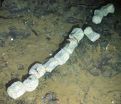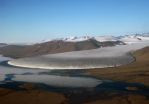(Press-News.org) Drs Lewis and Carré in the University's Department of Mechanical Engineering have been measuring the dynamic friction between the material of the ball and the skin on the fingertips and palm, and the mitts that some players choose to wear under different weather conditions. They're looking to answer one question: what's the best way to ensure that players don't fumble the ball?
"Catching and handling a ball with great skill and confidence is practically second nature to players at this level," says Dr Lewis. "But handling errors are still seen in professional rugby games and even more so in amateur rugby, so ball manufacturers are working constantly to provide extra grip to overcome the problems that occur, not all of which are related to player ability. Given that a slip at the wrong time could mean the difference between winning and losing a match, it's important that this potential is explored – and there's still scope for improvement." he said.
Rugby balls are now manufactured with pimples on the surface of their four panels to improve handling, and players may also wear fingerless gloves, known as mitts, which also have a surface texture to afford even greater grip, especially in wet conditions.
In a paper published in the journal Tribology International, Drs Lewis and Carré have shown that simply adding pimples to equipment does not necessarily deliver the intended result.
They believe that equipment manufacturers need to consider the implications of the dynamic friction produced by the different loads used in catching, throwing and manipulating the ball using different parts of the hand - and how the characteristics of the pimples interact with skin or mitts under the different conditions on match day.
"When we looked at the rugby balls themselves, used in dry conditions with no mitts, balls that had more closely spaced pimples were better for grip. But in wet or muddy conditions, the density of the pimples allowed a film of moisture to form between them, so in these conditions, a ball with wider pimple spacing is better," he said.
In addition, the researchers found that mitts with coarse texturing can have a detrimental effect on grip. "To truly work as intended, the texture on the mitts needs to interlock with the pattern on the ball. We found that mitts with coarse texturing actually reduced grip in some cases," said Dr Lewis. Of the mitts tested, synthetic leather mitts produced the overall best performance across all conditions, as the imposed texture interlocked best with the pimples on the ball.
Rugby ball manufacturers have introduced different pimple patterns for different types of rugby union, for example the pimple pattern on balls for 'rugby sevens', a form of rugby where the ball is almost constantly handled and rarely kicked, is more widely spaced than the pattern on balls for the conventional 15-player version of the game. "But this has been done without the fundamentals of textured visco-elastic material interactions with skin being fully understood, and in any case, our results show that the pimple pattern on the mitts is an equally important factor," says Dr Lewis.
Rather than being a criticism of current equipment design, Dr Lewis sees his results as an opportunity for sports equipment manufacturers. "Technology is helping athletes of all skill levels improve performance in so many other sports, why should rugby union be left out? Our work suggests that there's no one optimum design for all weathers, so manufacturers could design different balls targeted at countries with particular climates, for example. And our results could help feed some science into the design process of mitts too, to allow players to match the mitts' pimple design with the type of ball being used to ensure better interlocking. At the moment, adding texture is simply assumed to improve grip, but this isn't necessarily so."
### END
Six Nations Rugby Union: Were the gloves off?
2013-03-18
ELSE PRESS RELEASES FROM THIS DATE:
UM researcher revolutionizing scientific communication, one tweet at a time
2013-03-18
CORAL GABLES, FL (March 18, 2012) -- University of Miami (UM) doctoral student in Environmental Science and Policy, David Shiffman was invited to tweet updates in real-time, at the International Congress of Conservation Biology, New Zealand, 2011. As a result, more than 100,000 twitter users worldwide saw at least one tweet from the conference, and nearly 200 people from more than 40 countries, on six continents shared at least one tweet from the conference -- greatly exceeding the number of conference attendees.
"While live-tweeting is not a new phenomenon, ...
Antarctica's first whale skeleton found with 9 new deep-sea species
2013-03-18
Marine biologists have, for the first time, found a whale skeleton on the ocean floor near Antarctica, giving new insights into life in the sea depths. The discovery was made almost a mile below the surface in an undersea crater and includes the find of at least nine new species of deep-sea organisms thriving on the bones.
The research, involving the University of Southampton, Natural History Museum, British Antarctic Survey, National Oceanography Centre (NOC) and Oxford University, is published today in Deep-Sea Research II: Topical Studies in Oceanography.
"The planet's ...
Significant contribution of Greenland's peripheral glaciers to sea-level rise
2013-03-18
The scientists looked at glaciers which behave independently from the ice sheet, despite having some physical connection to it, and those which are not connected at all.
The discovery, just published in Geophysical Research Letters, is important as it will help scientists improve the predictions of the future contribution of Greenland's ice to sea-level rise.
Using lasers which measure the height of the ice from space, and a recently completed inventory of Greenland's glaciers and ice caps, scientists from the European-funded ice2sea programme, were able to determine ...
Male lions use ambush hunting strategy
2013-03-18
Washington, D.C.— It has long been believed that male lions are dependent on females when it comes to hunting. But new evidence suggests that male lions are, in fact, very successful hunters in their own right. A new report from a team including Carnegie's Scott Loarie and Greg Asner shows that male lions use dense savanna vegetation for ambush-style hunting in Africa. Their work is published in Animal Behavior.
Female lions have long been observed to rely on cooperative strategies to hunt their prey. While some studies demonstrated that male lions are as capable at hunting ...
Pneumonia patients nearly twice as likely to suffer from depression, impairments
2013-03-18
ANN ARBOR, Mich. — The long-term consequences of pneumonia can be more detrimental to a person's health than having a heart attack, according to joint research from the University of Michigan Health System and University of Washington School of Medicine.
Older adults who are hospitalized for pneumonia have a significantly higher risk of new problems that affect their ability to care for themselves, and the effects are comparable to those who survive a heart attack or stroke, according to the new findings in the American Journal of Medicine.
"Pneumonia is clearly not ...
Solar storm near Earth caused by fast CME
2013-03-18
VIDEO:
This NASA research model, prepared on Mar. 15, 2013, from a space weather model known as ENLIL named after the Sumerian storm god, shows the way the CME was expected...
Click here for more information.
On March 17, 2013, at 1:28 a.m. EDT, the coronal mass ejection (CME) from March 15 passed by NASA's Advanced Composition Explorer (ACE) as it approached Earth. Upon interacting with the giant magnetic bubble surrounding Earth, the magnetosphere, the CME caused a kind of ...
It's in the cards: Human evolution influences gamblers' decisions, study shows
2013-03-18
New research from an international team of scientists suggests evolution, or basic survival techniques adapted by early humans, influences the decisions gamblers make when placing bets.
The findings may help to explain why some treatment options for problem gamblers often don't work, the researchers say.
For the study, recently published in Frontiers in Psychology, scientists from McMaster University, the University of Lethbridge and Liverpool John Moores University examined how gamblers made decision after they won or lost.
They found that, like our ancestors, ...
Research find links between lifestyle and developing rheumatoid arthritis
2013-03-18
Researchers in Manchester have found a link between several lifestyle factors and pre-existing conditions, including smoking cigarettes and diabetes, and an increased risk of developing rheumatoid arthritis.
Rheumatoid Arthritis (RA) is a chronic disease which affects around 0.8% of the population; and its causes are of great interest to the medical world. Research led by Professor Ian Bruce, NIHR Senior Investigator and Professor of Rheumatology at The University of Manchester and consultant at Central Manchester University Hospitals NHS Foundation Trust, looked into ...
NASA sees leaping lunar dust
2013-03-18
Electrically charged lunar dust near shadowed craters can get lofted above the surface and jump over the shadowed region, bouncing back and forth between sunlit areas on opposite sides, according to new calculations by NASA scientists.
The research is being led by Michael Collier at NASA's Goddard Space Flight Center, Greenbelt, Md., as part of the Dynamic Response of the Environment At the Moon (DREAM) team in partnership with the NASA Lunar Science Institute (NLSI), managed at NASA's Ames Research Center, Moffett Field, Calif.
"The motion of an individual dust particle ...
Earth's interior cycles contributor to long-term sea-level & climate change, scientists conclude
2013-03-18
Ancient rises in sea levels and global warming are partially attributable to cyclical activity below the earth's surface, researchers from New York University and Ottawa's Carleton University have concluded in an analysis of geological studies.
However, the article's authors, NYU's Michael Rampino and Carleton University's Andreas Prokoph, note that changes spurred by the earth's interior are gradual, taking place in periods ranging from 60 million to 140 million years—far less rapidly than those brought on by human activity.
Their analysis appears in Eos, a newspaper ...



